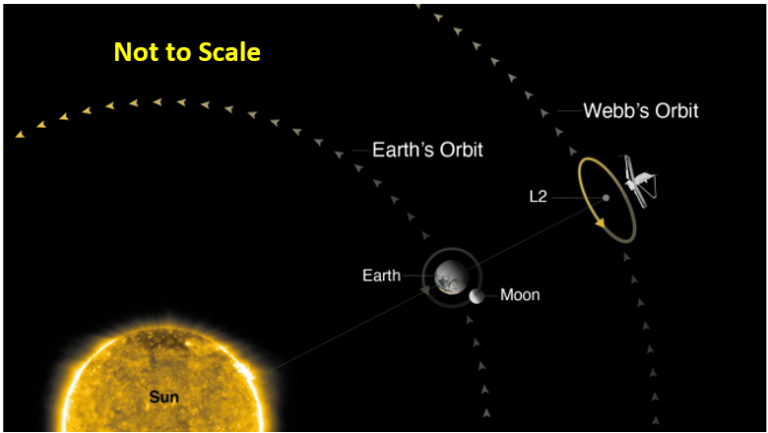JWST’s Precise Launch and Near-Perfect Course Corrections Mean Fuel Savings. And That Means a Longer Mission
By Nancy Atkinson
After a detailed analysis of where the James Webb Space Telescope is now (Dec. 29, 2021) and how it got there, NASA determined the observatory should have enough propellant to operate in space for significantly more than 10 years in space.
Webb’s mission lifetime was designed to be at least 5-1/2 years, and mission engineers and scientists were hoping for closer to 10 years.
The “significantly more than 10 years” announced today comes from two factors: the precision of the Ariane 5 launch on December 25, which experts say exceeded the requirements needed to put Webb on the right path. And now, because of how precise JWST’s trajectory has been, the first two mid-course correction maneuvers took significantly less fuel than expected.
The first course correction was a 65-minute burn after that took place about 12.5 hours after launch. While 65 minutes sounds like a long time, a burn lasting as long as 3 hours could have been required. That first burn put the observatory on an even more precise path and added approximately 45 mph (20 meters/sec) to the observatory’s speed. A second shorter correction maneuver on December 27, added around 6.3 mph (2.8 meters/sec) to the speed.
JWST’s lifetime is limited by the amount of fuel used for getting to L2 and maintaining its orbit, and also by the possibility that Webb’s components will degrade over time in the harsh environment of space.
The precise trajectory the observatory is now on means more propellant for orbit maintenance and momentum management down the road, which means a longer operational lifetime.
Which also means more science!

“The largest and most important mid-course correction (MCC), designated MCC-1a, has already been successfully executed as planned, beginning 12.5 hours after launch,” wrote Randy Kimble, JWST Integration, Test, and Commissioning Project Scientist, at NASA Goddard, in a blog post detailing the course correction maneuvers. “This time was chosen because the earlier the course correction is made, the less propellant it requires.”
The other big news from Webb is that the first parts of the tennis-court-sized sunshields have successfully deployed. On December 28, the forward and aft sunshield pallets were unfolded. As this report is being written, the Deployable Tower Assembly is being extended, a six-hour operation that was commanded remotely from the Operations Center. This tower creates space between the spacecraft and the telescope, giving the sunshield room to deploy. Once everything is deployed, this space will also help to keep the telescope cold.
If all goes well today, the next steps will be the release of the sunshield covers, the extension of the mid-booms, and finally the tensioning of the five Kapton layers of the sunshield itself. This will take place over the next several days. NASA says that because the deployment of the sunshield is one of the most challenging spacecraft deployments NASA teams have ever attempted, the mission operations team built flexibility into the planned timeline, so that the schedule and even sequence of the next steps could change in the coming days.
NASA also noted that on the “Where is Webb” website — where you can find all sorts of information about the observatory — new details are being added. You can now track the temperatures the spacecraft. Webb actually will have two different temperatures, due to being warm on one side and cold on the other. The sunshield will always be facing the Sun to block out heat and light, as Webb’s mirrors need to stay extremely cold to observe faint heat signals in the universe.
On the hot side, parts of Webb will reach temperatures as high as 85 degrees Celsius, or 185 degrees Fahrenheit. On the cold side Webb will be about -233 degrees Celsius, or -388 degrees Fahrenheit. NASA said temperatures will continue to change as Webb unfolds and then cools down to operating temperatures over the next months.
The post JWST’s Precise Launch and Near-Perfect Course Corrections Mean Fuel Savings. And That Means a Longer Mission appeared first on Universe Today.

December 30, 2021 at 01:18AM
via Universe Today read more...

Post a Comment